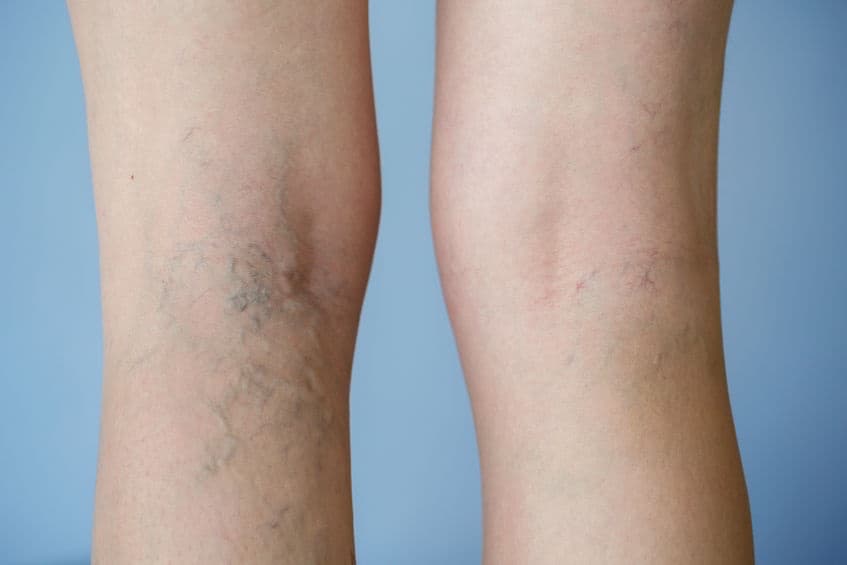If you have varicose veins, you’ve probably heard all kinds of advice and opinions about them. It’s never pleasant when people point out ugly veins, but you may be struggling to decide what to do next. Is it time for varicose vein treatment?
At Maryland Vascular Specialists, our doctors are vascular surgeons and vein/artery specialists who take a whole-body view of vein concerns. Your small spider veins could be symptoms of something much bigger, like chronic venous insufficiency (CVI).
It’s important to schedule an expert vein and artery consultation to rule out serious problems and understand the status of your varicose veins. Read on to learn more about varicose veins and how a vascular specialist can help you address them.
What Exactly are Varicose Veins?
Varicose veins are veins that are enlarged enough to see on the surface of the skin. They most commonly affect the legs and feet, although they may be on virtually any part of the skin.
Varicose veins usually look blue or purple. They may be flat or raised, and sometimes large enough to look like gnarled tree roots twisting across the skin. They are usually found on the legs. but can also be found on the lower abdominal and pelvic area. Smaller, flatter varicose veins are the type most often called spider veins.
The cause of varicose veins is essentially gravity plus blood flow restrictions within the body. Your legs work as pumps for the body’s blood. When the valves in your veins weaken, sometimes the result is a harmless spider vein and sometimes it can cause the walls of the veins themselves to weaken.
You’re certainly not alone in having varicose veins. They’re quite common, affecting half of all people over age 50 and about 55% of women and 45% of men in the United States.
Are Varicose Veins Dangerous?
People often wonder whether their varicose veins are cause for serious concern, and the answer is: perhaps yes, perhaps no. In some cases, they can simply be cosmetic. They can also be a sign of something deeper and much more dangerous.
Your veins are the carriers of blood as it returns to the heart. When the vein’s valves weaken, it can cause pain, discomfort, discoloration, leg fatigue, ulcers, and decreased mobility. Left untreated, vein problems can lead to a heart attack, stroke, amputation, or even death.
This is why it is so important to be evaluated by a vascular specialist. It’s hard to say whether your varicose veins should be cause for concern without a doctor’s diagnosis.
Are Varicose Veins Painful?
One important thing to understand about varicose veins is that you can’t judge them by a lack of pain. You may have them with or without pain – and either way, they could be a threat to your health.
When symptoms do occur, these are the most common:
- Changing color of veins or skin in the legs
- Hardening of the skin
- A heavy or aching feeling in the legs
- Burning, throbbing, itching, or cramping
- Bleeding and open sores
- Pain or a pulling feeling that extends along the length of the leg
Who is Most Likely to Get Varicose Veins?
Although anyone can get varicose veins, they are most prevalent in:
- Women over age 40, although men get them too
- People with a family history of varicose veins
- Sedentary people who spend long periods sitting
- Pregnant women
- People who are overweight or obese
Do Varicose Veins Go Away on Their Own?
For pregnant women, varicose veins usually fade within 12 months of giving birth, when the circulatory system adjusts back to normal.
Varicose veins that occur due to obesity or long periods of sitting can sometimes be helped by moderate daily exercise. However, they’re unlikely to go away completely – and you should check with your doctor before starting a new exercise routine because the valves in your veins may be damaged.
These veins don’t typically go away on their own. You’ll need a management plan from a vascular specialist to treat them appropriately.
Can Varicose Veins Be Prevented?
To some degree, varicose veins are simply hereditary and can’t be prevented. But you can also take preventive steps to keep them from forming and to promote body-wide health. Good circulation and strong muscle tone go a long way toward preventing vein problems.
Exercise regularly. As long as your doctor approves, try to get 30 to 45 minutes of moderate exercise several times a week. Occasional intense exercise isn’t necessarily the goal. For vein health, it’s better to get moderate exercise more regularly.
Maintain a healthy weight. Excess weight puts pressure on your veins. Talk to your doctor about your ideal weight. If you are overweight, plan to lose weight in a healthy way that promotes good circulation.
Avoid salt and fat. A diet that is low in salt and saturated fat supports vein health. Try to get more fiber in your diet and incorporate green, leafy vegetables. Drink plenty of water.
Limit heels and hosiery. High heels and tight hosiery can limit blood flow in your legs. Avoid wearing them, or if you must wear them, limit the time period and get moderate exercise after removing them to promote good blood flow.
Position thoughtfully. Change your sitting and standing position frequently throughout the day, moving through positions of elevating and lowering your legs. Practice good posture that promotes blood flow. If you have a job with extended periods of sitting or standing, take breaks that include at least 15 minutes of lower leg movement.
A Healthy View of Varicose Veins
If you are concerned about your varicose veins, it’s important to listen to your body and get advice from an expert. Connect with the specialists at Maryland Vascular Specialists for an evaluation.
Simply click below to schedule a consultation.
Talk to a vein specialist
